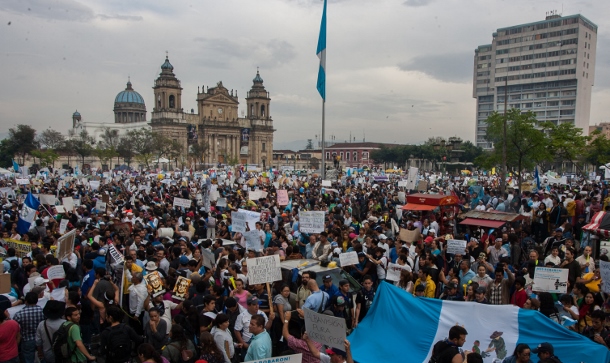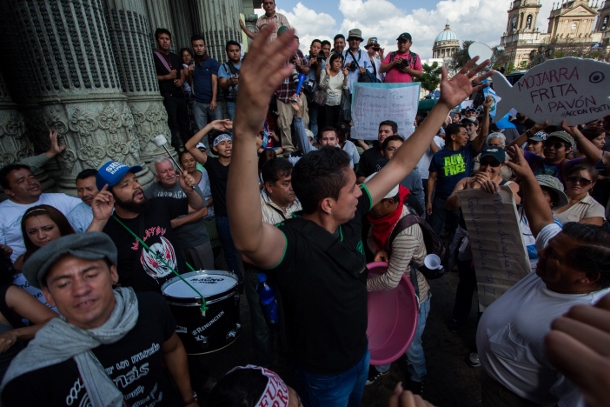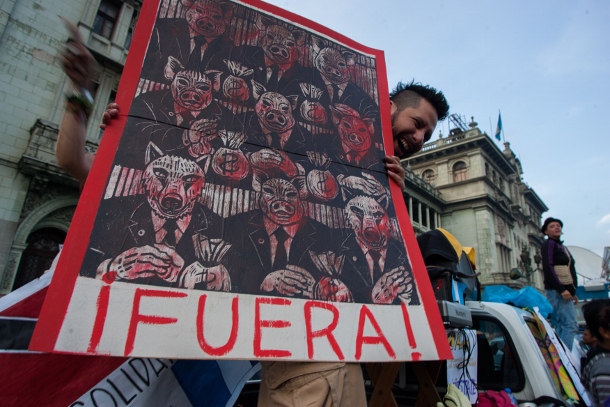
In spite of the thunder, lightning and torrential tropical rains that flooded the streets, nothing was going to stop nearly 65,000 Guatemalans from gathering to express their anger with a corrupt political class. The protests on May 16 were the continuation of a wave of popular indignation that has already forced two high-ranking government officials, including the vice president, to resign.
It was a historic day, as protesters marched from different points across the city, converging on Central Park of Guatemala City for the “Citizen’s Party.” It was a festive atmosphere, with piñatas depicting the president and former vice president, live music, a DJ, and tens of thousands of people from across Guatemalan society. “Not Otto Pérez, nor Roxana, could have imagined this citizen’s party,” protesters sang, referring to the country’s president and vice president, respectively.
“I went to the march because I feel a responsibility as a student and as a citizen of Guatemala to demand an end to corruption in my country,” said Maryam Chavez, a student at the University of San Carlos, who has participated in almost every march since they began in April. “We do not want Guatemala to be ruled by thieves, corrupted and murderous people that steal, kill and loot our natural resources, displacing our bothers and sisters from their lands. We want no more of this.”
Many others from across Guatemalan society echoed Chavez.
“It is time to be a part of the people who make change,” said Sal, a middle-class Guatemalan about his reason for joining the protest. “It is time to start acting, and to do something to make this a better country. And it is amazing that we’ve gotten this far pacifically.”
The march on May 16 is the continuation of the protests against corruption that began more than three weeks ago. The first march on April 25 drew nearly 35,000 people to the park to demand the resignation of President Otto Pérez Molina and Vice President Roxana Baldetti, who resigned on May 8.
A day of peaceful protest on April 25 was organized via Facebook, but quickly expanded beyond what the small group of activists had imagined thanks to social media and coverage by the national media. Many protesters are unaffiliated with any organization, and are simply concerned with the impact of the corruption on their families and communities.
Every protest that has been held since April 25 has come under intense police scrutiny. Each mobilization has included the deploying of surveillance equipment, including drones and cell phone signal blockers.
Growing corruption scandal
The Guatemalan political crisis began shortly after the International Commission Against Impunity in Guatemala, a United Nations-sponsored organization that was formed to combat Guatemala’s culture of impunity, released its findings from an investigation into a tax fraud scheme that had stolen nearly $120 million from Guatemalans in taxes. The report led to 22 orders for arrest for current and former members of the tax collection agency.
Initially, the administration of Otto Pérez Molina was able to avoid implication in the tax fraud ring, which became known as “The Line.” But the office of the president quickly became embroiled in the corruption scandal after the commission named Vice President Roxana Baldetti’s personal secretary, Juan Carlos Monzón, as the leader of “The Line.” Monzón then disappeared while on an official trip with the vice president to South Korea.
On April 19, Baldetti went before the press to distance herself from her former personal assistant, and ensure the public that she played no part in the scheme. But she abruptly ended the press conference after intense questioning by the Guatemalan and international press, which only added fuel to the budding protests and calls for her resignation.
The following day, protesters began a daily presence at the presidential palace calling for the resignation of the president and his vice president.
On May 8, a visibly distraught Pérez Molina went before the press to make the historic announcement that Baldetti had issued her resignation. He was quick to point out that she had made the “brave” decision for “personal” reasons, and not because of the “pressure” of anyone.

But protesters took the resignation as a sign of victory. Thousands gathered in Central Park to celebrate the resignation of the vice president, chanting “Yes we can” and “You didn’t resign, you were fired.” The protesters also had a message for President Pérez Molina: “You’re next.”
The resignation comes after the commission announced that it would be opening an investigation into Baldetti’s part in the crime ring.
The following week, the Guatemalan Congress approved Pérez Molina’s new vice president, Alejandro Maldonado Aguirre, a presidential candidate from the 1980s, former death squad member, and a Supreme Court justice who had played an important role in overturning the historic charges of genocide against former dictator Efrain Rios Montt. Protesters were quick to decry this choice, and quickly added Maldonado Aguirre’s resignation to their demands — there was even a piñata depicting the new vice president carrying a gun at the protests on May 16.
Guatemalan society rises up
As part of the “resign already” movement, the protests have exposed an entrenched dissatisfaction with politics as usual in Guatemala. But since the resignation of Baldetti, the movement’s demands have expanded to include the resignation of other politicians and reforms of the country’s Political Party Laws and elections.
The protesters have also turned their anger towards the candidates for the upcoming presidential election, which have traditionally been looked upon with cynicism because of the belief that whoever lost the previous election will win the next.
Presidential candidate Dr. Manuel Baldizón, a wealthy businessman with known connections to drug cartels, was recently met with protests at a political rally in the normally quiet tourist town of Antigua. The candidate refused to leave his car because of the protesters, and ultimately canceled the rally.
The protests have represented a diverse set of groups from Guatemalan society, which has had a long history of being deeply divided. Anger and indignation against their corrupt politicians has unified Guatemala, from Latino to indigenous, students to the elderly, and urban to rural.
The march was historic in more ways than one. On May 16, for the first time in the modern era, the students from the University of San Carlos marched alongside the students of the private universities of Guatemala. Historically, the universities of Guatemala have been divided along religious and doctrinal lines.
“The unification of the universities is fundamental,” said Tommy Morales, one of the student leaders at the University of San Carlos. “Students at San Carlos analyzed the situation, and we realized that we should understand that we are the people. It is with this message that we began reaching out to the students at other universities.”
The two groups of university students met south of Guatemala’s Central Park, and marched together to the square. It represented the unity of interests in this time of crisis.

For some, these protests against the administration are a continuation of the protests of indigenous and campesino communities against the expansion of extractive industries into their territories.
“Since the beginning of this administration in 2012, indigenous and campesinos communities have consistently denounced this government over the militarization of their communities, and the criminalization of leaders by the state in order to preserve an economic order,” said Paco from HIJOS Guatemala, an organization that advocates for the memory of those disappeared during Guatemala’s 36-year-long internal armed conflict. “This is the politics of eviction that the economic order has been trying to put into place since the signing of the peace accords [in 1996]. Unfortunately Guatemala City has historically been the center of the conservative vote, and they were not in agreement with those protests. But today, we are seeing a popular dissatisfaction with the politics of the right-wing parties emerge in the city.”
These communities have also participated in the growing movement against corruption. Many communities sent people to the city to participate in the mobilization.
“All of this is the result of our collective indignation with this corrupt state,” said Sol Acabol, a Maya Kiche from the Department of El Quiche, as she motioned to the protest. “We are seeing Guatemala rise up because of this case of corruption; but we know that that this problem is bigger than just the corruption — it is the system.”
As of this writing, there are no official plans for another day of mass protest like the one on May 16, but organizers have stated that they intend to continue the weekly protests calling for the resignation of Pérez Molina.
Campesino groups across the rural departments have called for blockades of highways. Students are continuing to hold public forums to discuss the crisis. For them, building networks among Guatemalan civil society is key for this movement to continue to grow. And on May 20, the Organization of Campesinos of the Verapazes is organizing a march down one of Guatemala’s busiest highways to demand the resignation of the president and other corrupt politicians.
“For this movement to continue writing history, we believe strongly in the continued coordination with all sectors of the country,” said Morales. “We need to create forms of dialogue and to continue to work among college students, peasant movements, indigenous movements, independent teachers, trade unions, etc, to propose workable solutions and create a legal base in these solutions.”
